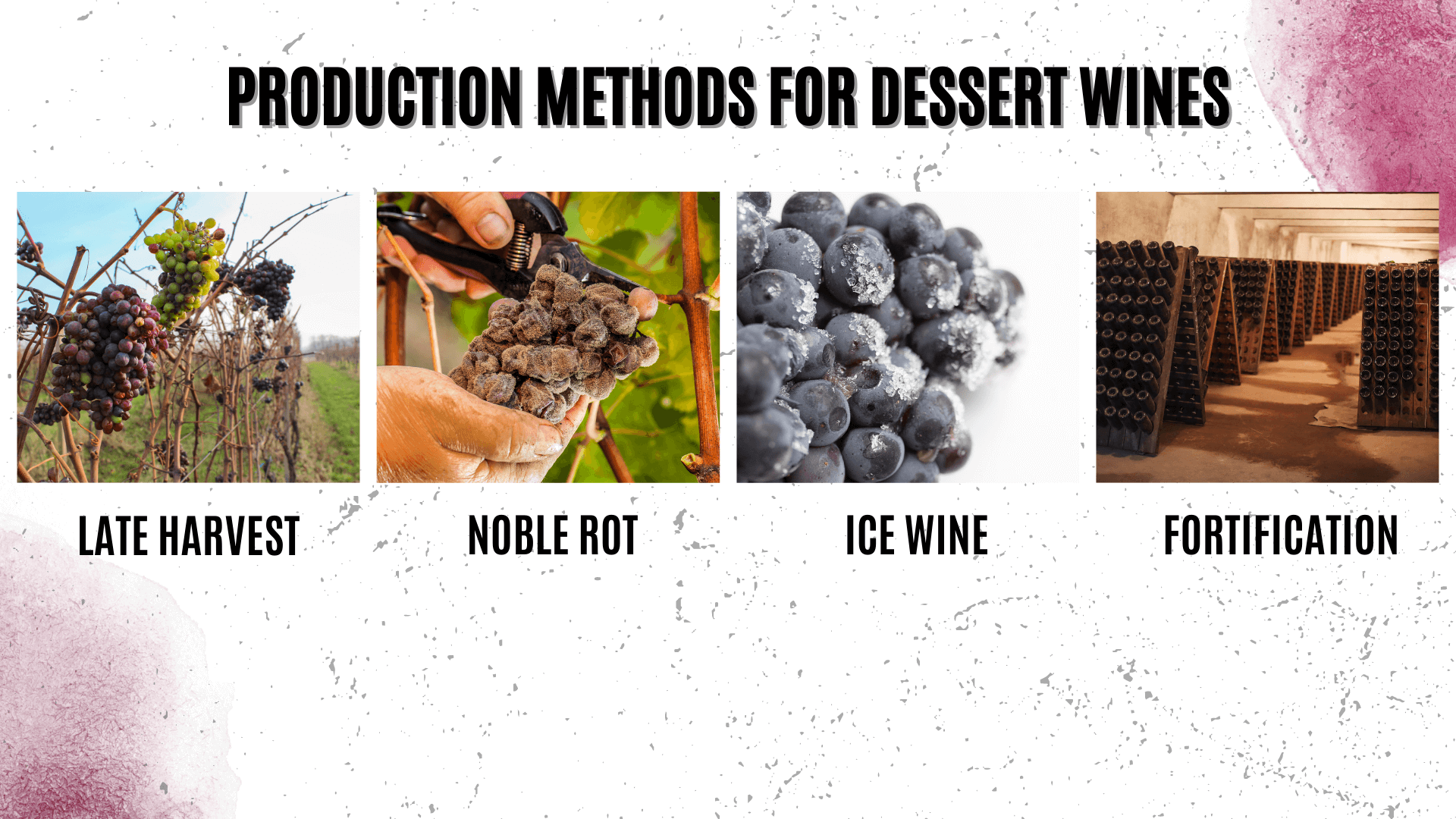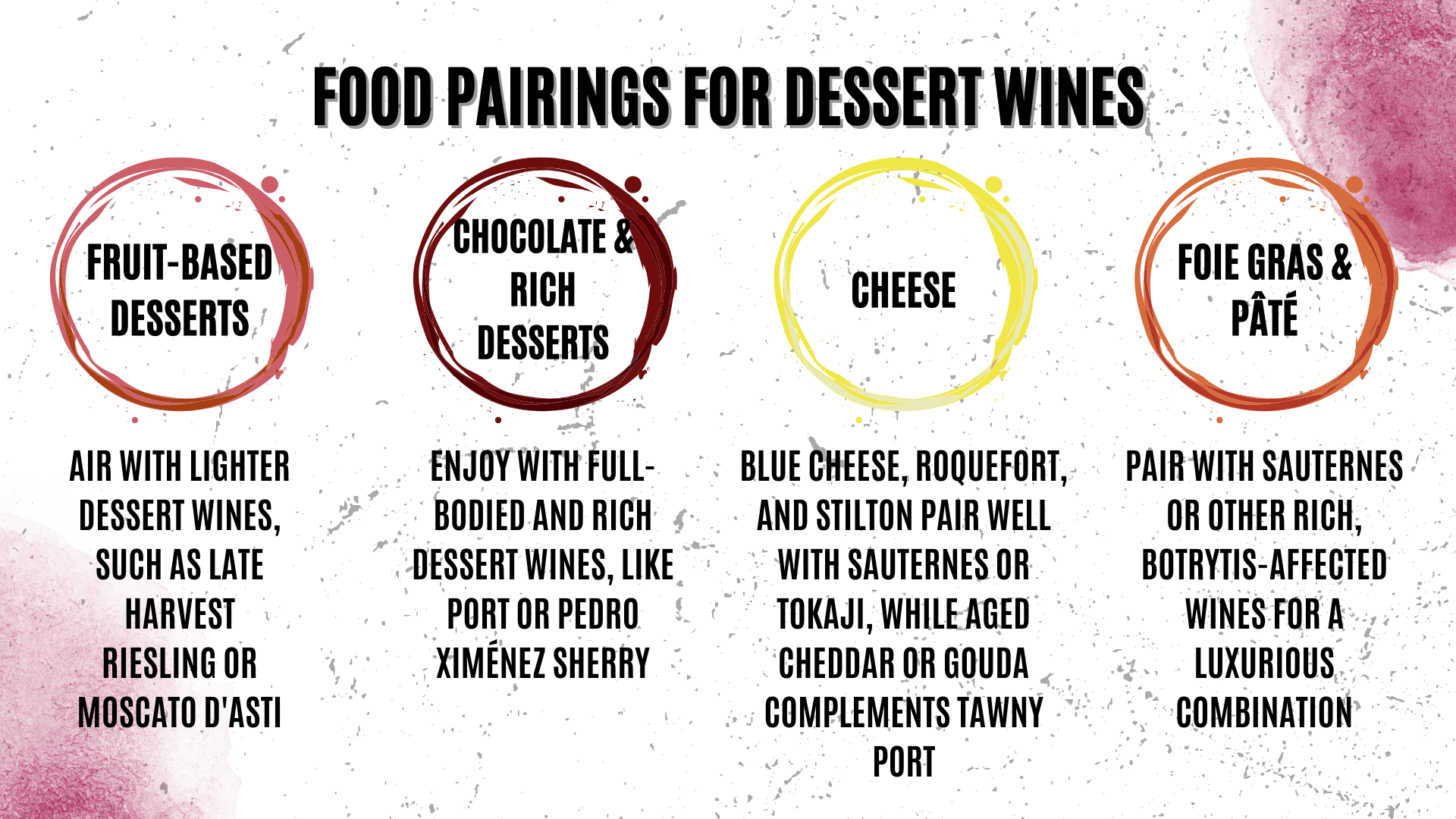Introduction
Dessert wines are a delightful treat to enjoy at the end of a meal or with sweet dishes. These wines can range from delicately sweet to intensely rich, and are made using various techniques and grape varieties. In this guide, we will discuss the different styles of dessert wines, their production methods, popular varieties, food pairings, and answer some frequently asked questions.

I. History of Dessert Wines
The history of dessert wines can be traced back to ancient civilizations like the Egyptians and Romans, who enjoyed sweet wines made from sun-dried grapes. Throughout the Middle Ages, the popularity of dessert wines grew, and they became a symbol of prestige and luxury. In modern times, dessert wines are enjoyed worldwide, with various styles and production methods that vary from region to region.
II. Production Methods for Dessert Wines
- Late Harvest – Grapes are left on the vine longer than usual, allowing them to accumulate more sugar and develop concentrated flavors.
- Botrytis Cinerea (Noble Rot) – A beneficial fungus that affects the grapes, causing them to shrivel and concentrate the sugars and flavors.
- Ice Wine – Grapes are harvested while frozen, resulting in highly concentrated juice with intense sweetness and acidity.
- Fortification – The addition of a neutral grape spirit to stop fermentation and retain residual sugar, creating a higher-alcohol, sweet wine.
III. Popular Dessert Wine Varieties
There are numerous popular dessert wine varieties that are well-loved for their sweetness and ability to complement a wide range of desserts. Some of the most popular varieties include:
- Sauternes: A sweet white wine from the Bordeaux region of France, Sauternes is made from Semillon, Sauvignon Blanc, and Muscadelle grapes affected by noble rot, giving it a rich, honeyed flavor with notes of apricot and peach.
- Port: A fortified wine from Portugal, Port is made from several grape varieties and comes in various styles such as Ruby, Tawny, and Vintage. It is known for its rich, sweet flavors of dark fruit, chocolate, and caramel.
- Tokaji Aszú: A Hungarian dessert wine made from grapes affected by noble rot, Tokaji Aszú is known for its intense sweetness, balanced by vibrant acidity, and flavors of dried fruits, honey, and spices.
- Ice Wine: Produced in cold climates like Canada and Germany, Ice Wine is made from grapes that have frozen on the vine, concentrating their sugars. This results in a sweet, intense wine with flavors of tropical fruits and honey.
- Muscat: Muscat-based dessert wines, such as Muscat de Beaumes-de-Venise from France and Moscato d’Asti from Italy, are known for their fruity and floral flavors, often featuring notes of apricot, peach, and orange blossom.
- Late Harvest Wines: Made from grapes left on the vine to develop higher sugar levels, late harvest wines can be found in various regions, including California and Alsace, and are known for their rich, sweet flavors of dried fruit and honey.
- Vin Santo: An Italian dessert wine made from dried grapes, Vin Santo has a rich, nutty flavor with notes of dried fruits, caramel, and honey.
- Banyuls: A fortified dessert wine from the Languedoc-Roussillon region of France, Banyuls is made from Grenache grapes and has flavors of dried fruits, chocolate, and coffee.
- Sherry: A fortified wine from the Jerez region of Spain, Sherry comes in a variety of styles, from dry to sweet. The sweeter styles of Sherry, such as Pedro Ximénez and Cream Sherry, are particularly suited for dessert pairings. Pedro Ximénez Sherry is made from sun-dried grapes, resulting in a rich, syrupy wine with flavors of dried fruits, figs, and molasses. Cream Sherry, a blend of Oloroso and Pedro Ximénez, has a velvety texture with notes of caramel, raisins, and toffee.
IV. Food Pairings for Dessert Wines
- Fruit-based desserts – Pair with lighter dessert wines, such as late harvest Riesling or Moscato d’Asti.
- Chocolate and rich desserts – Enjoy with full-bodied and rich dessert wines, like Port or Pedro Ximénez Sherry.
- Cheese – Blue cheese, Roquefort, and Stilton pair well with Sauternes or Tokaji, while aged cheddar or Gouda complements Tawny Port.
- Foie gras and pâté – Pair with Sauternes or other rich, botrytis-affected wines for a luxurious combination.
V. Fun Facts about Dessert Wines
- Botrytis cinerea, also known as noble rot, is a fungus that affects grapes, concentrating their sugars and flavors, resulting in the production of some of the world’s most exquisite dessert wines, such as Sauternes.
- Ice wine production involves leaving grapes on the vine until they freeze. The frozen grapes are then pressed, yielding a small amount of highly concentrated juice, resulting in sweet and flavorful ice wines.
- Fortified wines like Port and Sherry have played a significant role in dessert wine history, with their higher alcohol content and distinctive flavors contributing to their popularity as after-dinner drinks.
Frequently Asked Questions
Dessert wines should generally be served chilled, between 45-55°F (7-13°C), though some fuller-bodied and fortified wines may benefit from slightly warmer temperatures.
The aging potential of dessert wines varies greatly, with some meant for immediate consumption, while others can age for decades. Late harvest wines and ice wines can generally be aged for 5-10 years, while Sauternes, Tokaji, and fortified wines like Port and Sherry can age for several decades.
While dessert wines pair well with sweet dishes, they can also be enjoyed on their own or with savory foods like cheese, foie gras, or pâté. Dessert wines can offer a versatile and enjoyable experience beyond just dessert.






